PLYMOUTH GTX History
Introduction: Although
there had been numerous performance Plymouths, it wasn't until 1967 that
Plymouth offered one model with all the necessary performance goodies standard,
the 1967 Plymouth Belvedere GTX. Positioned as Plymouth's "gentlemen's"
hot rod, the GTX offered stylish performance for the discriminating buyer.
1967 Plymouth
GTX
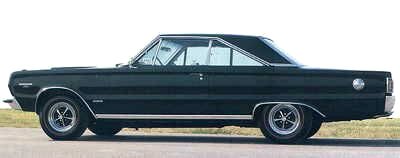 Comments:
The Plymouth Belvedere GTX was introduced in 1967 as Plymouth's first unified
performance model. Based on Plymouth's stylish two-door Belvedere hardtop
and convertible, the Belvedere GTX received a special grille and tail panel,
simulated hood scoops, and "pit stop" chrome gas cap. Twin racing stripes
were optional. The interior was pure luxury, with bucket seats, embossed
vinyl, and lots of brightwork. To make sure the GTX had the necessary firepower
to back up that image, Plymouth made the mighty 440 cid V8 (which Plymouth
called the "Super Commando 440") rated at 375 bhp standard. This engine
was usually used for Chysler's big cars but was tuned for more high-rpm
performance with a revised camshaft and valve train, and free-flowing intake
and exhaust systems. Optional was MOPAR's mighty 426 Hemi, rated at 425
bhp. Only 720 buyers forked over the extra 6 for the Hemi. Although
the 440 could keep up with the Hemi up to 70 mph, the Hemi was truly dominant
on the drag strip. The standard transmission was MOPAR's three-speed automatic
transmission. A four speed manual transmission was optional, and included
a larger ring gear, double-breaker distributor, free wheeling fan, and
an oil-pan windage tray. The GTX boasted superb handling, thanks to standard
six-leaf rear springs, heavy duty shocks, torsion bars, and ball joints,
though many believed that the power steering was too overassisted. Disc
brakes were optional, though didn't seem to provide much advantage over
the standard drum brakes. Comments:
The Plymouth Belvedere GTX was introduced in 1967 as Plymouth's first unified
performance model. Based on Plymouth's stylish two-door Belvedere hardtop
and convertible, the Belvedere GTX received a special grille and tail panel,
simulated hood scoops, and "pit stop" chrome gas cap. Twin racing stripes
were optional. The interior was pure luxury, with bucket seats, embossed
vinyl, and lots of brightwork. To make sure the GTX had the necessary firepower
to back up that image, Plymouth made the mighty 440 cid V8 (which Plymouth
called the "Super Commando 440") rated at 375 bhp standard. This engine
was usually used for Chysler's big cars but was tuned for more high-rpm
performance with a revised camshaft and valve train, and free-flowing intake
and exhaust systems. Optional was MOPAR's mighty 426 Hemi, rated at 425
bhp. Only 720 buyers forked over the extra 6 for the Hemi. Although
the 440 could keep up with the Hemi up to 70 mph, the Hemi was truly dominant
on the drag strip. The standard transmission was MOPAR's three-speed automatic
transmission. A four speed manual transmission was optional, and included
a larger ring gear, double-breaker distributor, free wheeling fan, and
an oil-pan windage tray. The GTX boasted superb handling, thanks to standard
six-leaf rear springs, heavy duty shocks, torsion bars, and ball joints,
though many believed that the power steering was too overassisted. Disc
brakes were optional, though didn't seem to provide much advantage over
the standard drum brakes.
Production: 2D Coupe:
11,429 2D Hardtop: 686
Engines: 426 Hemi
V8 425bhp@5000rpm, 490lb-ft@4000rpm. 440 V8 375bhp@4600rpm, 480lb-ft@3200rpm.
Performance: 440/375bhp:
0-60 in 6.6 sec, 1/4 mile in 15.2 sec @ 97 mph. 426/425: 0-60 in 4.8 seconds,
1/4 mile in 13.5 seconds @ 105 mph.
1968 Plymouth
GTX
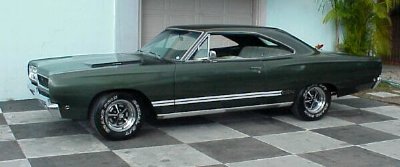 Comments:
In 1968, the GTX was moved upscale with the addition of the budget Plymouth
Road Runner. Both shared the same redesigned Belvedere platform. Styling
changes included a new hood design with different non-functional hood vents,
a new grille, and revised taillights. In keeping with its upscale image,
the GTX was available as either a two door hardtop or convertible, whereas
the Road Runner was only available as a pillared coupe. The Road Runner
came with a strengthen 383 cid V8 as standard, while the GTX came with
the 440 V8 standard. Both had the mighty 426 Hemi as the only engine option.
Both cars had similar suspension upgrades, and wide-oval tires; front disc
brakes and a limited slip differential were options on both. Non-functional
hood vents were common to both. The GTX came with the TorqueFlite automatic
transmission as standard (it cost 6 extra on the Road Runner), with
a four speed manual transmission as a no cost option. Instead of the plain
exterior of the Road Runner, the GTX looked upscale with standard chrome
wheel-lip moldings, tailpanel brightwork, and double side stripes. Inside,
whereas the Road Runner had a fleet-grade interior, the GTX came with the
well-appointed Sport Satellite cabin featuring shiny details and fake woodgrain.
These differences were reflected in the base prices, ,034 for the Road
Runner pillared coupe and ,355 for the GTX hardtop. Serious racers loved
the Hemi, but only 450 GTXs (414 hardtops and 36 convertibles) were ordered
with the 4 option. The 440 was easier to tune, and churned out a surplus
of low-end torque, which was more useable on the street, than the rev-happy
Hemi. Deficiencies mirrored those of the Road Runner and most muscle car
intermediates -- a stiff ride, over assisted power steering, and unsure
handling on rough roads. But overall, the GTX was a true gentleman's super
car. Comments:
In 1968, the GTX was moved upscale with the addition of the budget Plymouth
Road Runner. Both shared the same redesigned Belvedere platform. Styling
changes included a new hood design with different non-functional hood vents,
a new grille, and revised taillights. In keeping with its upscale image,
the GTX was available as either a two door hardtop or convertible, whereas
the Road Runner was only available as a pillared coupe. The Road Runner
came with a strengthen 383 cid V8 as standard, while the GTX came with
the 440 V8 standard. Both had the mighty 426 Hemi as the only engine option.
Both cars had similar suspension upgrades, and wide-oval tires; front disc
brakes and a limited slip differential were options on both. Non-functional
hood vents were common to both. The GTX came with the TorqueFlite automatic
transmission as standard (it cost 6 extra on the Road Runner), with
a four speed manual transmission as a no cost option. Instead of the plain
exterior of the Road Runner, the GTX looked upscale with standard chrome
wheel-lip moldings, tailpanel brightwork, and double side stripes. Inside,
whereas the Road Runner had a fleet-grade interior, the GTX came with the
well-appointed Sport Satellite cabin featuring shiny details and fake woodgrain.
These differences were reflected in the base prices, ,034 for the Road
Runner pillared coupe and ,355 for the GTX hardtop. Serious racers loved
the Hemi, but only 450 GTXs (414 hardtops and 36 convertibles) were ordered
with the 4 option. The 440 was easier to tune, and churned out a surplus
of low-end torque, which was more useable on the street, than the rev-happy
Hemi. Deficiencies mirrored those of the Road Runner and most muscle car
intermediates -- a stiff ride, over assisted power steering, and unsure
handling on rough roads. But overall, the GTX was a true gentleman's super
car.
Production: 2D Coupe:
17,914. 2D Convertible: 2,026.
Engines: 426 Hemi
V8 425bhp@5000rpm, 490lb-ft@4000rpm. 440 V8 375bhp@4600rpm, 480lb-ft@3200rpm.
Performance: 426/425bhp:
1/4 mile in low 13s. 440/375bhp: 0-60 in 6.6 sec, 1/4 mile in 15.2 sec
@ 97mph
1969 Plymouth
GTX
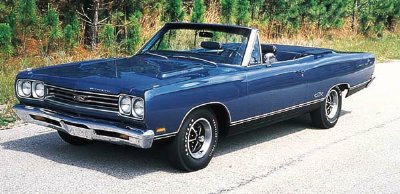 Comments:
The Road Runner gained a convertible and two door hardtop for 1969, which
hurt GTX sales. The GTX received minor front and rear cosmetic changes,
which included new rectangular side markers, and a new (but very similar)
grille and taillight treatment. On the performance side, the GTX was now
available with a wider choice of rear axles, and a Hurst shifter. Also
new was the Air Grabber option, which consisted of dual air intakes in
the hood with a dash-controlled shut off. The Hemi, a 0.90 option, was
ordered on just 198 hardtops and only 11 GTX convertibles. A third engine
option for the GTX appeared in mid-1969. Plymouth took the 440 V8 and replaced
the single four barrel carb with three two barrel carbs and put out a solid
390 bhp. Called the 440+6, it was just a 9 upgrade over the standard
440, still rated at 375 bhp. Comments:
The Road Runner gained a convertible and two door hardtop for 1969, which
hurt GTX sales. The GTX received minor front and rear cosmetic changes,
which included new rectangular side markers, and a new (but very similar)
grille and taillight treatment. On the performance side, the GTX was now
available with a wider choice of rear axles, and a Hurst shifter. Also
new was the Air Grabber option, which consisted of dual air intakes in
the hood with a dash-controlled shut off. The Hemi, a 0.90 option, was
ordered on just 198 hardtops and only 11 GTX convertibles. A third engine
option for the GTX appeared in mid-1969. Plymouth took the 440 V8 and replaced
the single four barrel carb with three two barrel carbs and put out a solid
390 bhp. Called the 440+6, it was just a 9 upgrade over the standard
440, still rated at 375 bhp.
Production: 15,602.
Engines: 426 Hemi
V8 425bhp@5000rpm, 490lb-ft@4000rpm. 440 V8 375bhp@4600rpm, 480lb-ft@3200rpm.
440+6 V8 390bhp@4700rpm, 490lb-ft@3200rpm.
Performance: 440/375:
1/4 mile in mid 14s at mid 90s mph.
1970 Plymouth
GTX
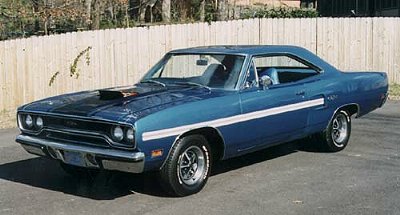 Comments:
The 1970 GTX received new smoother lines, but lost its convertible model.
The new styling featured a power bulge hood and non-functional rear brake
scoops. Optional 15x7 Rallye wheels with F60-15 Goodyear tires became available
for the first time. Under the hood, buyers could choose from a 440 with
375 bhp (the same as the year before, but with a lower compression ratio),
the 440+6 with 390 bhp and the 426 Hemi rated at 425 bhp. Optional with
the 440+6, and standard with the Hemi was the latest version of the Air
Grabber hood, which featured a single flap which could be raised or lowered
from inside the car. Typical of the time, the flap featured a shark decal
on the side, just the thing for psyching out the competition at the stoplight.
But the GTX was always heavier than the Road Runner and thus it was slower.
Sales continued to suffer and only 7,748 GTXs were sold. Only 72 were ordered
with the Hemi and 768 with the 440+6. Comments:
The 1970 GTX received new smoother lines, but lost its convertible model.
The new styling featured a power bulge hood and non-functional rear brake
scoops. Optional 15x7 Rallye wheels with F60-15 Goodyear tires became available
for the first time. Under the hood, buyers could choose from a 440 with
375 bhp (the same as the year before, but with a lower compression ratio),
the 440+6 with 390 bhp and the 426 Hemi rated at 425 bhp. Optional with
the 440+6, and standard with the Hemi was the latest version of the Air
Grabber hood, which featured a single flap which could be raised or lowered
from inside the car. Typical of the time, the flap featured a shark decal
on the side, just the thing for psyching out the competition at the stoplight.
But the GTX was always heavier than the Road Runner and thus it was slower.
Sales continued to suffer and only 7,748 GTXs were sold. Only 72 were ordered
with the Hemi and 768 with the 440+6.
Production: 7,748.
Engines: 426 Hemi
V8 425bhp@5000rpm, 490lb-ft@4000rpm. 440 V8 375bhp@4600rpm, 480lb-ft@3200rpm.
440+6 V8 390bhp@4700rpm, 490lb-ft@3200rpm.
1971 Plymouth
GTX
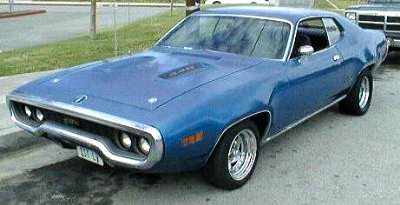 Comments:
As somewhat of a surprise, the GTX returned for 1971. It was slightly smaller
than the year before, and rode on a wheelbase one inch shorter at 115 inches.
Its new styling was curvaceous and very attractive, The fuselage styling
featured rounded fenders and a loop bumper front and rear. A new hood with
cutouts was standard and a revised Air Grabber was optional. The windshield
wipers were now hidden and the side markers were larger. The GTX also received
a wider rear track to improve handling. Under the hood, the GTX was not
watered down like some of its competitors and still came with its 440 standard
(though down 5 bhp to 370 bhp) and the 440+6 and Hemi were still optional.
Sales were down to just 2,942 units (only 30 with the Hemi), and this would
spell the end of the GTX, and the Hemi engine. The GTX would reappear as
an option on the Road Runner for 1972. Comments:
As somewhat of a surprise, the GTX returned for 1971. It was slightly smaller
than the year before, and rode on a wheelbase one inch shorter at 115 inches.
Its new styling was curvaceous and very attractive, The fuselage styling
featured rounded fenders and a loop bumper front and rear. A new hood with
cutouts was standard and a revised Air Grabber was optional. The windshield
wipers were now hidden and the side markers were larger. The GTX also received
a wider rear track to improve handling. Under the hood, the GTX was not
watered down like some of its competitors and still came with its 440 standard
(though down 5 bhp to 370 bhp) and the 440+6 and Hemi were still optional.
Sales were down to just 2,942 units (only 30 with the Hemi), and this would
spell the end of the GTX, and the Hemi engine. The GTX would reappear as
an option on the Road Runner for 1972.
Production: 2,942.
Engines: 426 Hemi
V8 425bhp@5000rpm, 490lb-ft@4000rpm. 440 V8 370bhp@4600rpm, 480lb-ft@3200rpm.
440+6 V8 390bhp@4700rpm, 490lb-ft@3200rpm.
Performance: 440/370:
1/4 mile in 15 seconds @ 95 mph.
|